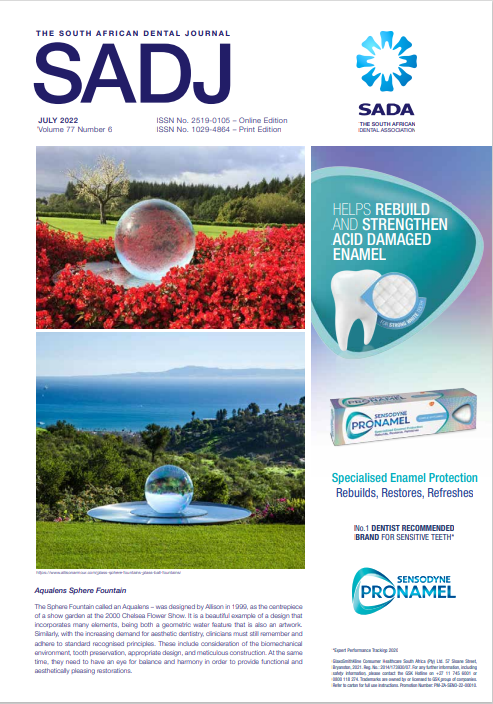A review of the 2030 Human Resources for Health Strategy and Vision: Goals and their implications for dentistry
DOI:
https://doi.org/10.17159/2519-0105/2022/v77no6a2Keywords:
implications, demographicAbstract
The South African National Department of Health(NDoH) released a report in March 2020: “2030 Human Resources for Health (HRH) Strategy: Investing in the Health Workforce for Universal Health Coverage”. The aim was to analyse the five National Health Goals
for 2030 with reference to the impact they could have on dentistry in South Africa. This was an independent review of the HRH strategic
document with inputs from three specialists in Community Dentistry. The views are that of the authors and not necessarily from the report itself. The strategic document comprised of five goals and each goal’s objectives implication to dentistry was analysed based on the SMART criteria. Some of the goals are being attained but to meet the remaining goals, government has to increase its commitment to improving oral health. More posts in the public sector needs to be created, managerial posts need to be filled by community dentistry specialists, current managers need to be upskilled, the number of mid-level workers (MWs) posts (oral hygienists and
dental therapists) need to be increased and the MWs financial package needs to be improved. The tertiary institutions need to train oral health workers who are aligned with the oral disease burden, introduce careerpathways for MWs and assist in supporting oral health research and training of oral health managers. In terms of oral health, there is an urgent need to determine and align the disease burden and these goals. There should be an increase in the number of MWs, existing managers need to be upskilled,
and adverts for managerial posts need to have clear criteria for the required skills.
Downloads
References
Bhayat A, Nkambule NR, Madiba TK. A review of the 2030 human resources for health strategy: Implications for dentistry in South Africa. South African Dental Journal. 2021; 76(6):367-72.
Les MacLeod EdD M. Making smart goals smarter. Physician executive. 2012; 38(2):68.
Mukhari-Baloyi NA, Bhayat A, Madiba TK, Nkambule NR. A review of the South African National Oral Health Policy. South African Dental Journal. 2021; 76(9):551-7.
Birch S, Ahern S, Brocklehurst P, Chikte U, Gallagher J, Listl S, et al. Planning the oral health workforce: Time for innovation. Community Dentistry and Oral Epidemiology. 2021; 49(1):17-22.
Van Wyk PJ,Van Wyk C. Oral health in South Africa. International Dental Journal. 2004; 54:373-7.
Van Wyk P, Louw A, Du Plessis J. Caries status and treatment needs in South Africa: Report of the 1999-2002 National Children's Oral Health Survey. South African Dental Journal. 2004; 59(6):238-240.
Bhayat A, Madiba TK, Nkambule NR. A three-year audit of dental services at primary health care facilities in Gauteng, South Africa: 2017 to 2019. Journal of International Society of Preventive & Community Dentistry. 2020; 10(4):452.
Smit D, Barrie R, Louw A. The burden of dental caries in the Western Cape and a recommended turn around strategy. South African Dental Journal. 2017; 72(8):360-5.
Thema LK, Singh S. Integrated primary oral health services in south africa: The role of the phc nurse in providing oral health examination and education: Open forum. African Journal of Primary Health Care and Family Medicine. 2013; 5(1):1-4.
Singh S. Dental caries rates in south africa: Implications for oral health planning. Southern African Journal of Epidemiology and Infection. 2011; 26(4):259-61.
Bhayat A, Vergotine G, Yengopal V, Rudolph MJ. The impact of service-learning on two groups of south african dental students. Journal of Dental Education. 2011; 75(11):1482-8.
Phalwane MG. Perceptions of newly-qualified oral healthcare professionals about their exposure to service learning in their final year of training at the Sefako Makgatho Health Sciences University, South Africa: Stellenbosch: Stellenbosch University; 2019. https://scholar.sun.
ac.za/bitstream/handle/10019.1/107102/phalwane_perceptions_2019.pdf?sequence=1&isAllowed=y
Makwakwa N, Motloba PD. Dental malpractice cases in South Africa (2007-2016). South African Dental Journal. 2019; 74(6):310-5.
Klinck E. Department of Health releases Human Resource Strategy (continued). Occupational Health Southern Africa. 2012; 18(1):32-3.
Labonté R, Sanders D, Mathole T, Crush J, Chikanda A, Dambisya Y, et al. Health worker migration from South Africa: Causes, consequences and policy responses. Human resources for health. 2015; 13(1):1-16.
Henderson LN, Tulloch J. Incentives for retaining and motivating health workers in Paciffic and Asian countries. Hum Resour Health. 2008:6(1):1-20
Downloads
Published
Issue
Section
License

This work is licensed under a Creative Commons Attribution-NonCommercial 4.0 International License.






.png)